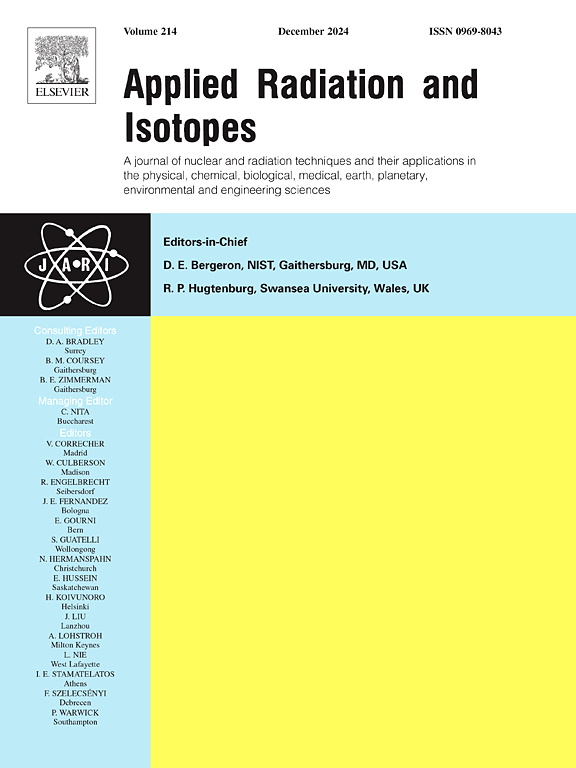Study of the application of the deformed dose summation (DDS) method in brachytherapy for advanced cervical cancer and analysis of regional dosing in recurrent cervical cancer
IF 1.8
3区 工程技术
Q3 CHEMISTRY, INORGANIC & NUCLEAR
引用次数: 0
Abstract
Purpose
This study evaluated the cumulative brachytherapy (BT) dose in cervical cancer using different methods and explored using deformed dose summation (DDS) techniques for assessing doses to targets and organs at risk (OAR).
Methods
A total of 41 patients with cervical cancer who underwent BT were retrospectively analyzed, the cumulative dose, measured as the equivalent dose in 2 Gy fractions, was calculated using dose–volume histogram (DVH) superposition and DDS methods. The dice similarity coefficient (DSC), Jaccard coefficient (JC), and mean distance to agreement (MDA) were utilized to evaluate the deformable image registration (DIR) accuracy. Furthermore, the difference between the target and OAR doses obtained through the two methods was calculated and compared. The Spearman method was employed to analyze dose differences and geometric correlations, comparing the dose in the relapsing area with that in the post-fusion high-risk clinical target volume (HR-CTV) in patients experiencing relapse to identify potential associations.
Results
In evaluating deformable registration, the registration outcomes for both the bladder and rectum were deemed satisfactory. The DSC, JC, and MDA values for the bladder and rectum were calculated as follows: 0.89 ± 0.07, 0.81 ± 0.09, 2.14 ± 1.44 mm and 0.80 ± 0.08, 0.67 ± 0.10, 2.28 ± 1.80 mm, respectively. Compared to DVH superposition, DDS techniques reduced the average cumulative doses of the D2cc and D0.1 cc of bladder by 11.4 % and 8.2 %, respectively; and the doses of the D2cc and D0.1 cc of rectum to be decreased by 9.7 % and 14.1 %, respectively. Additionally, the D90 of HR-CTV and Intermediate risk CTV (IR-CTV) were reduced by 6.60 ± 3.70 Gy and 4.55 ± 2.70 Gy, respectively. No significant correlation was observed between DSC, JC, and MDA and the dose difference. No correlation was observed between the relapsing regional dose and the dose parameters related to the HRCTV following fusion.
Conclusions
Calculating the cumulative dose using DVH parameters is a conservative approach that may limit target dose enhancement. During planning, DIR can guide clinicians in selecting the target dose and visually display the cumulative dose distribution in the cervical target area.
变形剂量总和法(DDS)在晚期宫颈癌近距离放疗中的应用研究及复发性宫颈癌局部给药分析
目的评价不同方法下宫颈癌近距离累积放疗(BT)剂量,探讨变形剂量总和(DDS)技术对靶及危险器官(OAR)剂量的评估。方法回顾性分析41例行BT治疗的宫颈癌患者的累积剂量,采用剂量-体积直方图(DVH)叠加和DDS法计算累积剂量,以2 Gy的当量剂量计量。利用骰子相似系数(DSC)、Jaccard系数(JC)和平均一致距离(MDA)来评价变形图像配准(DIR)的精度。此外,计算和比较了两种方法获得的靶剂量和桨剂量的差值。采用Spearman方法分析剂量差异和几何相关性,将复发区剂量与复发患者融合后高危临床靶体积(HR-CTV)剂量进行比较,以确定潜在的关联。结果在评价可变形配准时,膀胱和直肠的配准结果均令人满意。膀胱、直肠DSC、JC、MDA值分别为0.89±0.07、0.81±0.09、2.14±1.44 mm和0.80±0.08、0.67±0.10、2.28±1.80 mm。与DVH叠加相比,DDS技术将膀胱D2cc和D0.1 cc的平均累积剂量分别降低了11.4%和8.2%;直肠D2cc和D0.1 cc的剂量分别减少9.7%和14.1%。HR-CTV和IR-CTV的D90分别降低了6.60±3.70 Gy和4.55±2.70 Gy。DSC、JC、MDA与剂量差异无明显相关性。融合后复发区域剂量与HRCTV相关剂量参数无相关性。结论使用DVH参数计算累积剂量是一种保守的方法,可能会限制靶剂量的增强。在计划过程中,DIR可以指导临床医生选择目标剂量,直观显示子宫颈靶区的累积剂量分布。
本文章由计算机程序翻译,如有差异,请以英文原文为准。
求助全文
约1分钟内获得全文
求助全文
来源期刊

Applied Radiation and Isotopes
工程技术-核科学技术
CiteScore
3.00
自引率
12.50%
发文量
406
审稿时长
13.5 months
期刊介绍:
Applied Radiation and Isotopes provides a high quality medium for the publication of substantial, original and scientific and technological papers on the development and peaceful application of nuclear, radiation and radionuclide techniques in chemistry, physics, biochemistry, biology, medicine, security, engineering and in the earth, planetary and environmental sciences, all including dosimetry. Nuclear techniques are defined in the broadest sense and both experimental and theoretical papers are welcome. They include the development and use of α- and β-particles, X-rays and γ-rays, neutrons and other nuclear particles and radiations from all sources, including radionuclides, synchrotron sources, cyclotrons and reactors and from the natural environment.
The journal aims to publish papers with significance to an international audience, containing substantial novelty and scientific impact. The Editors reserve the rights to reject, with or without external review, papers that do not meet these criteria.
Papers dealing with radiation processing, i.e., where radiation is used to bring about a biological, chemical or physical change in a material, should be directed to our sister journal Radiation Physics and Chemistry.
 求助内容:
求助内容: 应助结果提醒方式:
应助结果提醒方式:


